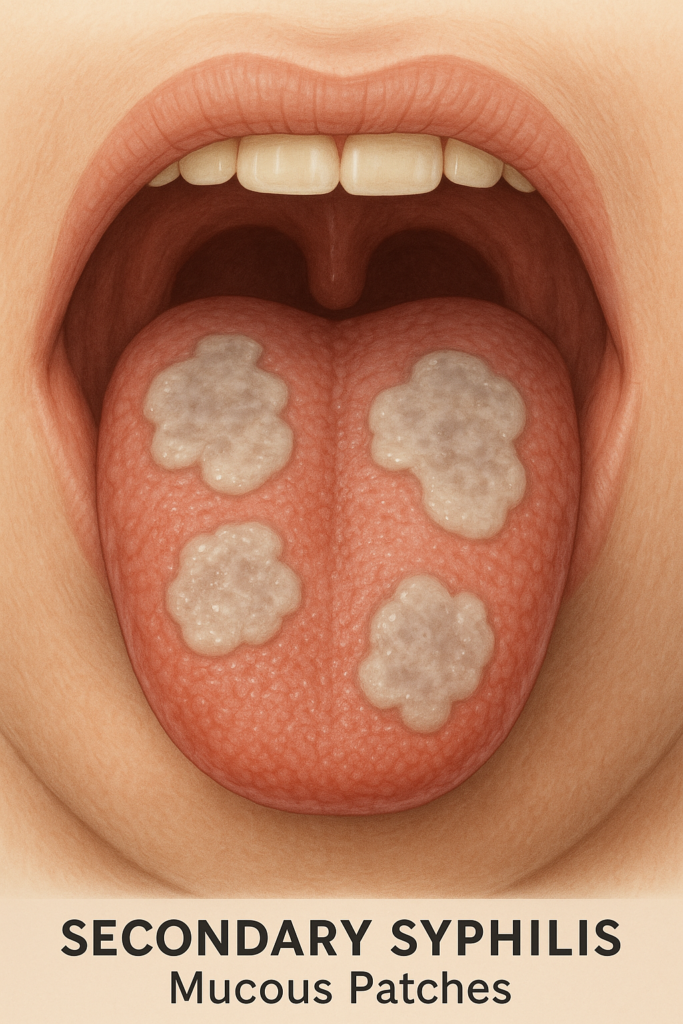Syphilis is a sexually transmitted infection (STI) caused by a bacterium called Treponema pallidum. While many people commonly associate syphilis with genital sores, the infection can also affect the mouth, including the tongue, lips, gums, and inner cheeks. When syphilis appears in the mouth, it is generally referred to as oral syphilis. Due to low awareness and the fact that these lesions can look similar to other mouth problems, oral syphilis is often misdiagnosed or undetected, which allows the infection to spread further.
Understanding how syphilis affects the mouth is important for early identification, treatment, and prevention. This article explains what oral syphilis looks like, how it progresses, and when to seek medical attention.
How Syphilis affects Enters the Mouth
Syphilis spreads mainly through direct contact with a syphilis sore, known as a chancre. These sores can be present on:
- Genitals
- Anus
- Lips
- Tongue
- Inner mouth surfaces
Because syphilis can be transmitted through oral sex and kissing, it is possible to get syphilis even without vaginal or anal intercourse. When a person comes into contact with a partner’s active sore during oral sex, the bacteria can infect the mouth.
Stages of Syphilis affects and Oral Symptoms
Syphilis progresses through four stages, and the appearance of mouth lesions can vary depending on the stage.
1. Primary Stage: Painless Ulcers
In the primary stage, a painless round sore (chancre) may appear:
- On the tongue
- On the lip
- On the gums
- Inside the cheek
Key Characteristics:
- Round or oval
- Smooth edges
- Does not hurt
- Heals on its own in 3 to 6 weeks
Because it is painless, many people ignore it or assume it is a harmless mouth sore. However, the infection remains in the body and will progress if untreated.
2. Secondary Stage: Patches and Widespread Lesions
If the infection is not treated early, it enters the secondary stage. In this phase, the bacteria spread throughout the body, leading to more noticeable symptoms in the mouth.
Common Oral Symptoms:
- White, gray, or yellowish patches on the tongue or inside cheeks (called mucous patches)
- Smooth, reddish, shiny areas on the tongue (called glossitis)
- Cracked corners of the mouth
- Swollen lymph nodes in the neck
- Mild sore throat without cold or infection
What makes mucous patches unique?
- They are painless
- They may appear in clusters
- They do not scrape off like oral thrush
These lesions are highly infectious, meaning syphilis can easily spread through kissing or oral contact at this stage.
3. Latent Stage: No Visible Symptoms
In the latent stage, the infection becomes silent. There are no mouth sores or body symptoms, but the bacteria remain inside the body, sometimes for years.
Without treatment, syphilis may silently progress to the tertiary stage, which can be life-threatening.
4. Tertiary Stage: Severe Tissue Damage
Although rare today due to widespread treatment, untreated syphilis over several years can lead to:
- Damage to the brain (neurosyphilis)
- Heart damage (cardiovascular syphilis)
- Gumma formation (large destructive ulcers)
In the mouth, gummas appear as large, deep, destructive ulcers on the tongue or palate. These can be extremely painful and permanently affect speech and eating.
How Oral Syphilis affects Symptoms Differ From Other Conditions
Oral syphilis can be mistaken for many common mouth conditions. Here is how to differentiate:
| Condition | How It Differs from Oral Syphilis |
| Canker Sores | Painful; syphilis sores are usually painless |
| Oral Thrush | White patches scrape off; syphilis patches do not scrape off |
| Leukoplakia | Thick white patches linked to smoking; less likely to resolve |
| Oral Herpes | Painful, fluid-filled blisters that burst; syphilis sores are firm and round |
If there is any uncertainty, testing is the only way to confirm the diagnosis.
Diagnosis
Doctors diagnose syphilis using:
- Blood tests (like VDRL, RPR, TPHA)
- Physical examination of oral lesions
- Sometimes swab or biopsy for confirmation
Testing is quick and confidential. Anyone who has mouth sores after sexual exposure should be tested.
Treatment
The most effective treatment for all stages of syphilis is:
Penicillin G injection
Treatment Facts:
- A single dose may be enough in the early stage
- Later stages may require multiple doses
- Symptoms improve quickly, but it is important to complete treatment
- Sexual partners should also be tested and treated
Never attempt to treat syphilis with home remedies or over-the-counter medicine — they do not work.
When to See a Doctor
Seek medical attention if you notice:
- A painless sore anywhere in or around your mouth
- Unusual white or gray patches on the tongue
- Red smooth patches that do not go away
- Sore throat without signs of infection
- Swollen neck lymph nodes
Early diagnosis and treatment prevent severe health problems and stop infection spread.
Syphilis affects-Prevention Tips
- Use condoms and dental dams during oral sex
- Avoid kissing or sexual contact if you or your partner has visible sores
- Get tested regularly if sexually active
- Encourage partners to test as well
Conclusion
Syphilis can affect the mouth in several ways, most commonly through painless tongue sores and white mucous patches. Because these symptoms are often overlooked, oral syphilis can progress and spread before it is recognized. The good news is that syphilis is completely curable, especially when treated early with penicillin.
If you notice unexplained tongue changes or oral lesions — do not ignore them.
Consult a healthcare provider for testing and treatment. Early action protects both your health and the health of others.

